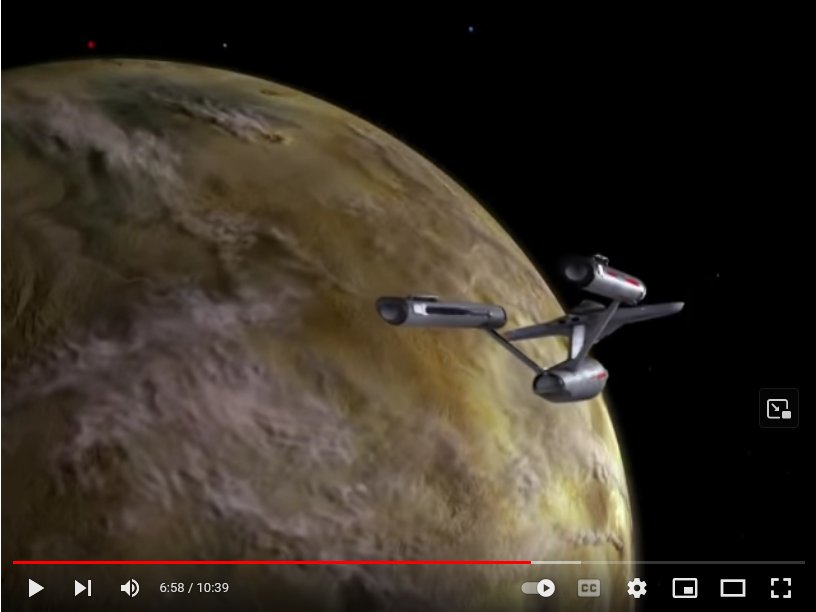Remember this? Remind you of anything?
This is the logo that would appear at the end of a Universe Pictures movie in the 1930s. It was the modern world and planes flew around the world! As the video shows. Did anyone see this literally, as a depiction of how a small plane would fly around the globe? In a flat plane and curving to follow the Earth’s surface? One hopes not.
Here’s what it reminded me of the other day.
This of course is an example how the starship Enterprise orbited a planet in the original Star Trek series of the 1960s. (This is a screenshot from this YouTube compilation of Season 1 TOS planets. Also, it’s clearly from the remastered versions of those episodes, as released in the 2000s, when special effects were improved and picture quality was enhanced; the planetary surface here is much more detailed than those in the original series produced in the 1960s.)
Still, whenever you see a shot like this, of the Enterprise approaching or moving away, it’s clearly moving on an arcing path, as if following the surface of the sphere beneath it. And further, the ship is *banking* just as a plane would bank as it makes an arcing, curving path through the air.
Alas, these depictions are just as nonsensical as the 1930s plane flying flat around the globe. First of the scale is grotesquely wrong; a planet is so large, even if the Enterprise needed to arc and bank to be in orbit, the amount it would so in a few seconds is infinitesimally small and would not be noticed. And anyway an orbiting object wouldn’t arc and bank, nor would it need to. Its orientation would remain fixed with respect to the stars, the outer universe, regardless of its position above the planet. That’s physics 101.
Still, it appears visually intuitive, doesn’t it? Just as the stars streaming past the Enterprise as it flies through the galaxy gives an appropriate sense of great speed. But that too is absurd; just compare the distances between stars, and the speeds the Enterprise is supposed to be going, even at warp 10 or whatever. It would still take years to move from one star to another, let alone see stars streaming past. They didn’t follow their premises (about warp speeds) through to be sure their special effects made sense.
Of course Star Wars is far worse.
Admittedly, it’s difficult to dramatize situations far outside ordinary human experience without appealing to ordinary human experience. Thus Star Wars‘ fighters bank and swoop like jet fighters in an atmosphere; thus the Enterprise makes an audible swoosh as it passes the viewer.
Even 2001: A Space Odyssey, one of the most scrupulously-accurate science fiction films of all time, gives in to this, either deliberately or in error. In shots of the Discovery, when seen full-length against a background of stars, we see that background inching very slightly past. But the ship is only moving from Earth to Jupiter; the stars are so greatly farther away, they wouldn’t be seen moving at all.
\
I understand that most people don’t care about such infelicities; it’s just a movie, it’s just a TV show. But I maintain that it’s profoundly significant that people don’t care. It means they’re comfortable living in a fantasy version of reality; it means that can only interpret reality through the filter of intuitive human nature; and it suggests that ultimately humanity may fail or refuse to understand reality even as it threatens survival of the species. I’ve gone about this before, and will again.






